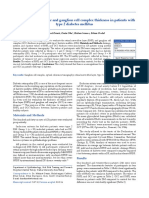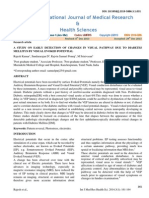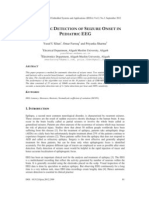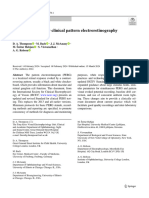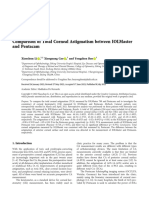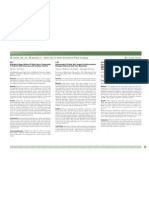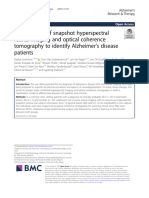The Multifocal ERG in Early Detection of Diabetic Retinopathy
The Multifocal ERG in Early Detection of Diabetic Retinopathy
Uploaded by
Ram1028Copyright:
Available Formats
The Multifocal ERG in Early Detection of Diabetic Retinopathy
The Multifocal ERG in Early Detection of Diabetic Retinopathy
Uploaded by
Ram1028Original Title
Copyright
Available Formats
Share this document
Did you find this document useful?
Is this content inappropriate?
Copyright:
Available Formats
The Multifocal ERG in Early Detection of Diabetic Retinopathy
The Multifocal ERG in Early Detection of Diabetic Retinopathy
Uploaded by
Ram1028Copyright:
Available Formats
The Multifocal ERG in Early Detection of Diabetic
Retinopathy
XU Jin
1
, HU Guangshu
1
, HUANG Tianna
2
, HUANG Houbin
2
CHEN Bin
2
1. Department of Biomedical Engineering, Tsinghua University, Beijing 100084, China
2. Department of Ophthalmology, General Hospital of Chinese PLA, Beijing 100853, China
Abstract- To assess retinal changes in diabetic eyes at early
stage of retinopathy, retinal responses were examined using
multifocal ERG. Seven healthy subjects, 16 diabetics with no
apparent retinopathy (NDR) and 9 diabetics who had back-
ground diabetic retinopathy (BDR) underwent multifocal
ERG testing. The first slice of the second order kernel (K21)
were extracted from multifocal ERG record and summed.
Three major peaks (P1, N1 and P2) on the trace of summed
K21 are evaluated across all subjects. With their amplitude
and implicit time as 6 features, linear classifiers were built.
These classifiers were used to discriminate eyes of control,
NDR and BDR subjects. The classification error dropped sig-
nificantly.
Keywords- diabetic retinopathy, early detection, multifocal
ERG, second order kernels
I. INTRODUCTION
Diabetic Retinopathy (DR) is a major cause of blind-
ness in modern society. It is a common microvascular com-
plication in patients with diabetes and may have a sudden
and debilitating impact on visual acuity, eventually leading
to blindness. DR is a progressive disease. According to se-
verity level, it includes the following stages: no apparent
DR, background DR, and proliferative DR [1]. To know
when to initiate treatment of diabetic retinopathy and to
prevent visual loss, testing methods are needed to detect
retinal changes as early as we can, better before BDR hap-
pened.
As hyperglycemia caused by diabetes impairs the ret-
ina from the beginning, most of retinal changes during this
pre-retinopathy period are functional and can not be ob-
served by traditional clinical methods, like ophthalmoscope.
Electrophysiological methods are looked as important tools
to find functional abnormities of retina in the early stage of
DR [2]. Multifocal electroretinogram (mfERG) is a newly
developed advanced electrophysiological technique [3]. It
enables simultaneous ERG testing of multiple small retinal
areas and allows a fast, objective evaluation of retinal func-
tion. Hood has made a comprehensive review on the
mechanism and applications of mfERG in 2001[4].
mfERG responses have shown significantly reduced
amplitudes and response delays in diabetic eyes, with or
without retinopathy [5,6,7]. The problem is that, in early
stages of DR, the infection of DR on mfERG response is
very weak [4]. So, recognition rate between healthy sub-
jects, subjects without DR and subjects with BDR is low at
present. For example: when amplitude of mfERG responses
was evaluated, only half of diabetic eyes were correctly
discriminated from normal eyes in [7]; in [6], 12 out of 18
diabetic eyes have the same range of implicit time with
those eyes of non-diabetics. In this study, our purpose is to
increase the classification performance.
According to extraction rule, one first order kernel and
several high order kernels can be extracted out of every
mfERG record. And second order kernels are suggested
more sensitive for the detection of early changes in retinal
function of diabetics than the commonly considered first
order kernel [5,7]. In this study, the first slice of second
order kernel (K21) of mfERG was used.
II. DATA PREPARATION
Twenty five non-insulin-dependent diabetic pa-
tients(56.113.1 years of age, duration of diabetes, 5~30
years) were examined. 16 of them had no apparent DR,
attributed to group NDR; the other 9 had background DR,
attributed to group BDR. The NDR and BDR eyes were
classified by ophthalmoscopic examination and fluorescein
angiography. The control group was consisted of 7 volun-
teers with healthy retina(52.314.3 years of age). Pupils
were dilated maximally. The t-test results showed no dif-
ference between the results obtained from subjects in whom
only one eye was analyzed and those obtained from sub-
jects in whom both eyes were analyzed. Therefore, results
from both eyes of every subject were included in this study.
MfERG tests were performed on a visual evoked re-
sponse imaging system (Veris Science
TM
5.2). The visual
stimulation consisted of 103 scaled hexagons array on a
CRT screen placed in front of subjects and stimulate the
central 50of the retina (Fig. 1). Each stimulus hexagons
flickers between two binary states (black or white) con-
trolled by a predetermined m-sequence. A shifted version of
the same sequence can be used to control different areas.
Retinal responses were derived from the cornea by means
of a Burian-Allen bipolar contact lens electrode, amplified
(50,000 gain) and band pass filtered 10300 Hz. By per-
forming a cross-correlation between the m-sequence for a
particular area and the mixed retinal response with a com-
puter, it is possible to recover the small independent multi-
focal ERG responses.
As shown in Fig.1, every mfERG recording produces
103 focal K21s corresponding with 103 regions on the ret-
ina. To simplify the comparison, all K21s were summed
across the entire array for each mfERG recording. (The
word K21 in following discussion means this summed re-
sult.)
Proceedings of the 2005 IEEE
Engineering in Medicine and Biology 27th Annual Conference
Shanghai, China, September 1-4, 2005
0-7803-8740-6/05/$20.00 2005 IEEE.
7762
Authorized licensed use limited to: Sri Sivasubramanya Nadar College of Engineering. Downloaded on August 18, 2009 at 23:09 from IEEE Xplore. Restrictions apply.
Fig.1. The schematics of a multifocal ERG system.
III METHOD AND RESULT
A typical summed K21 is shown in Fig.2. It has a
waveform structure including three major peaks (P1, N1,
and P2).
Fig.2. Typical waveform of summed K21
Comparing K21 from control, NDR and BDR subjects,
the amplitude and implicit time of all three peaks changed
in different level. And these two features of peak P2 scat-
tered in a wider range and alter more significantly than that
of P1 and N1. The distribution of peak P2 among subjects
from three groups was shown in Fig.3. In Fig.3 (a), the im-
plicit time of P2 obviously distributed in a narrower area
within control group. And the amplitude of P2 reduced sig-
nificantly along with the progression of DR in Fig.3 (b).
The average amplitude is 2.50V for control group, 1.44V
for NDR group and 1.09V for BDR group. When the am-
plitude control range of P2 was set to 1.5V, the minimum
value among control subjects, 22 out of 32 NDR subjects
and 15 out of 18 BDR subjects fell below the range line.
This result is not good enough to discriminate eyes of sub-
jects in this study.
(a)
(b)
Fig.3. The implicit time and amplitude of P2 of the summed K21. Those
* points represent data from control subjects, o represent NDR,
represent BDR. Short transverse lines in (b) indicate average amplitude of
every group. The dashed line indicates the range of control.
To increase the recognition rate, we synthesize im-
plicit time and amplitude of peak P2. Every point in Fig.4
has these two features as the x-coordinate and the
y-coordinate respectively. Those dark lines in Fig. 4 served
as the decision boundary of the two-feature linear classifiers.
The classification results in Fig.4 were also shown by con-
fusion matrix in Table.1.
7763
Authorized licensed use limited to: Sri Sivasubramanya Nadar College of Engineering. Downloaded on August 18, 2009 at 23:09 from IEEE Xplore. Restrictions apply.
Fig. 4 Scatter plot of P2 from control, NDR and BDR subjects. Dark lines
indicate the decision line of linear classifiers.
Table.1. Confusion matrices from Fig.4
a) Control subjects versus NDR subjects
Classification Labels
True Labels
Control NDR
Totals
Control 12 2 14
NDR 3 29 32
b) Control subjects versus BDR subjects
Classification Labels
True Labels
Control BDR
Totals
Control 13 1 14
BDR 2 16 18
c) NDR subjects versus BDR subjects
Classification Labels
True Labels
NDR BDR
Totals
NDR 16 16 32
BDR 5 13 18
According to Fig.4 and Table.1, the classification error
significantly decreased when linear classifiers based on
amplitude and implicit time of peak P2 were used. But,
classification result between NDR subjects and BDR sub-
jects is still far from good.
To increase the classification performance, both of
amplitude and implicit time of peaks P1, N1 and P2 were
used as 6 features of linear classifiers. The linear discrimi-
nant function g(x) is given in formula (1). Among subjects
from three group, there are three two-category linear classi-
fiers need to be built. Value of the weight vector W and the
threshold weight w
0
were computed by minimizing the er-
rors in the least square sense (the algorithm is described in
[8]), and listed in Table.2.
0
1 1_ ImplicitTime
2 1_ ImplicitTime
3 2 _ ImplicitTime
( )
4 1_ Amplitude
5 1_ Amplitude
1 2 _ Amplitude
w P
w N
w P
g x w
w P
w N
P
T
( (
( (
( (
( (
= - +
( (
( (
( (
( (
(1)
Table.2. Weight vector and threshold weight of the linear discriminant
function
1
:
2
Control : NDR Control : BDR NDR : BDR
w
0
-8.84 -0.0552 121.95
w
1
0.138 0.217 7.52
w
2
0.00285 -0.371 -10.36
w
3
0.0858 0.0633 -0.00547
w
4
0.0532 0.364 2.33
w
5
0.267 -0.114 -6.27
Then compute g(x) of formula (1) for all subjects in
control, NDR and BDR groups. The unit of amplitude is
microvolt, and that of implicit time is millisecond. Classify
all subjects according to the sign of g(x):
1
2
if ( ) 0,
if ( ) 0,
g x x
g x x
e
e
> e
< e
(2)
Because the number of features is 6, these three linear
classifiers can not be visualized as in Fig.4. Confusion ma-
trices of these classifiers are given in Table.3.
Table.3. Confusion matrices for those classifiers with 6 features
a) Control subjects versus NDR subjects
Classification Labels
True Labels
Control NDR
Totals
Control 12 2 14
NDR 3 29 32
b) Control subjects versus BDR subjects
Classification Labels
True Labels
Control BDR
Totals
Control 14 0 14
BDR 0 18 18
c) NDR subjects versus BDR subjects
Classification Labels
True Labels
NDR BDR
Totals
NDR 30 2 32
BDR 4 14 18
The classification performance is further increased
compared with previous classifiers with two features. At
this situation, the early detection of diabetic retinopathy
becomes possible.
Above results prove the efficiency of pattern recogni-
tion method in mfERG application of early detection of
diabetic retinopathy. And there are still works need to be
done: In above discussion, only two-category classifier was
used. According to clustering of subjects in this study,
multi-class classifier should be designed to deal with the
early detection of DR. On the other hand, the amplitude and
implicit time of P1, N1 and P2 may not be the best features
in the classification, which suggests that feature extraction
may be executed before the classification.
7764
Authorized licensed use limited to: Sri Sivasubramanya Nadar College of Engineering. Downloaded on August 18, 2009 at 23:09 from IEEE Xplore. Restrictions apply.
REFERENCE
[1] SC Brailsford, R Davies, C Canning and PJ Roderick, Evaluating
screening policies for the early detection of retinopathy in patients
with non-insulin dependent diabetes, Health Care Management
Science. Vol.1, pp. 115124, 1998
[2] R Tzekov, GB Arden, The electroretinogram in diabetic retinopa-
thy, Survey of Ophthalmology, Vol. 44(1), pp. 53-60, 1999
[3] EE Sutter and D Tran, The field topography of ERG components in
man--I. The photopic luminance response, Vision Research, Vol. 32,
pp. 433-466, 1992
[4] DC Hood, Assessing fetinal function with the multifocal technique,
Progress in Retinal and Eye Research, Vol. 19(5), pp. 607-646, 2000
[5] AM Palmowski, EE Sutter, MA Bearse, W Fung, Mapping of retinal
function in diabetic retinopathy using the multifocal electroretino-
gram, Investigative Ophthalmology and Visual Science, Vol. 38, pp.
25862596, 1997
[6] B Fortune, ME Schneck, AJ Adams, Multifocal electroretinogram
delays reveal local retinal dysfunction in early diabetic retinopathy,
Investigative Ophthalmology and Visual Science, Vol. 40, pp.
26382651, 1999
[7] Y Shimada, Y Li, MA Bearse, EE Sutter, W Fung, Assessment of
early retinal changes in diabetes using a new multifocal ERG proto-
col, British Journal of Ophthalmology, Vol. 85, pp. 414419, 2001
[8] OD Richard, EH Peter, GS David, Pattern Classification (2nd Edi-
tion), Wiley-Intersciencepp.239-249, 2000
7765
Authorized licensed use limited to: Sri Sivasubramanya Nadar College of Engineering. Downloaded on August 18, 2009 at 23:09 from IEEE Xplore. Restrictions apply.
You might also like
- Peat 1Document37 pagesPeat 1Denise Junio100% (6)
- Retinal Nerve Fiber Layer and Ganglion Cell Complex Thickness in Patients With Type 2 Diabetes Mellitus Original ArticleDocument2 pagesRetinal Nerve Fiber Layer and Ganglion Cell Complex Thickness in Patients With Type 2 Diabetes Mellitus Original ArticledrblurryfaceNo ratings yet
- DR RatnaDocument6 pagesDR RatnaNi Kadek Eno YuliantariNo ratings yet
- 31 Rajesh EtalDocument4 pages31 Rajesh EtaleditorijmrhsNo ratings yet
- Comparing CVA Defects To Local RNFLDocument9 pagesComparing CVA Defects To Local RNFLkagone walidNo ratings yet
- PIIS0002939422002732Document10 pagesPIIS0002939422002732Anca Florina GaceaNo ratings yet
- 6401 FullDocument7 pages6401 FullYunita CahyadikaNo ratings yet
- To Assess The Glaucoma Diagnostic Ability of Fourier Domain Optical Coherence TomographyDocument7 pagesTo Assess The Glaucoma Diagnostic Ability of Fourier Domain Optical Coherence TomographyAJER JOURNALNo ratings yet
- Retinal ImagesDocument7 pagesRetinal ImagesKallur AkshathaNo ratings yet
- Automatic Diagnosis of The 12-Lead ECG Using A Deep Neural NetworkDocument9 pagesAutomatic Diagnosis of The 12-Lead ECG Using A Deep Neural NetworkHema VisvanathanNo ratings yet
- ERG GuidelinesDocument15 pagesERG GuidelinesImtiaz AhmedNo ratings yet
- Conference 1Document10 pagesConference 1Digambar PuriNo ratings yet
- Retinal Nerve Fiber Loss in High-And Normal-Tension Glaucoma by Optical Coherence TomographyDocument4 pagesRetinal Nerve Fiber Loss in High-And Normal-Tension Glaucoma by Optical Coherence TomographyRaditya BagusNo ratings yet
- Jurnal Kel. 1Document3 pagesJurnal Kel. 1ho himmaNo ratings yet
- Natissiyan. 2019. Study Visual Functions in Epileptic Patients During DepakoteDocument3 pagesNatissiyan. 2019. Study Visual Functions in Epileptic Patients During DepakoteRuth RachmawatyNo ratings yet
- Anorexia ReprintDocument6 pagesAnorexia ReprintdoctorwhoiswhoNo ratings yet
- ComputerDocument12 pagesComputerokuwobiNo ratings yet
- Automatic Detection of Seizure ONSET in Pediatric EEGDocument9 pagesAutomatic Detection of Seizure ONSET in Pediatric EEGijesajournalNo ratings yet
- X-Linked Cone Dystrophy Caused by Mutation of The Red and Green Cone OpsinsDocument14 pagesX-Linked Cone Dystrophy Caused by Mutation of The Red and Green Cone OpsinsJohnny GoteNo ratings yet
- PDF JTN 164Document4 pagesPDF JTN 164Gede SuputraNo ratings yet
- The Evaluation of Retinal Nerve Fiber Layer Thickness in Subjects With Insulin ResistanceDocument6 pagesThe Evaluation of Retinal Nerve Fiber Layer Thickness in Subjects With Insulin ResistancexcdNo ratings yet
- A First Step Towards Eye State Prediction Using EEG: Oliver R Osler and David SuendermannDocument4 pagesA First Step Towards Eye State Prediction Using EEG: Oliver R Osler and David SuendermannCoryDinGospoNo ratings yet
- Diagnostic Ability of Retinal Ganglion Cell Complex, RetinalDocument7 pagesDiagnostic Ability of Retinal Ganglion Cell Complex, RetinalYoselin Herrera GuzmánNo ratings yet
- Advances in The Management of Diabetic Macular Oedema Based On Evidence From The Diabetic Retinopathy Clinical Research NetworkDocument11 pagesAdvances in The Management of Diabetic Macular Oedema Based On Evidence From The Diabetic Retinopathy Clinical Research NetworkNatalia LeeNo ratings yet
- TMP 768 BDocument8 pagesTMP 768 BFrontiersNo ratings yet
- Hood2012 Article ISCEVStandardForClinicalMultifDocument13 pagesHood2012 Article ISCEVStandardForClinicalMultifNeocresf CresfNo ratings yet
- Clinical Characteristics of CyclodeviationDocument7 pagesClinical Characteristics of Cyclodeviationcarlosalladoa0% (1)
- Boe 13 1 65Document17 pagesBoe 13 1 65Rajesh KrishananNo ratings yet
- 52 58 Semenko V.V. ENDOTHELINE 1s DYNAMICS IN NON PROLIFERATIVE DIABETIC RETINOPATHY AND ITS CORRECTION WITH LARGININE PDFDocument7 pages52 58 Semenko V.V. ENDOTHELINE 1s DYNAMICS IN NON PROLIFERATIVE DIABETIC RETINOPATHY AND ITS CORRECTION WITH LARGININE PDFTito saragihNo ratings yet
- Correlation Between Ocular Parameters and Amplitude of AccommodationDocument4 pagesCorrelation Between Ocular Parameters and Amplitude of AccommodationAdityaNoorRachmanNo ratings yet
- Comparative Analysis of Refractive and Topographic Changes in Early and Advanced Keratoconic Eyes Undergoing Corneal Collagen CrosslinkingDocument6 pagesComparative Analysis of Refractive and Topographic Changes in Early and Advanced Keratoconic Eyes Undergoing Corneal Collagen CrosslinkingMohamad Hasnol HayatNo ratings yet
- Discus (Denniss Et Al, Sept07.09)Document18 pagesDiscus (Denniss Et Al, Sept07.09)Paul H ArtesNo ratings yet
- Relationship Between Cognitive Impairment And.4 PDFDocument7 pagesRelationship Between Cognitive Impairment And.4 PDFMary GomezNo ratings yet
- Detection and Removal of Non-Responsive Channels and Trials in Evoked Potentials Using Median TestDocument10 pagesDetection and Removal of Non-Responsive Channels and Trials in Evoked Potentials Using Median TestsipijNo ratings yet
- 2022 Article 3375Document9 pages2022 Article 3375S3bsNo ratings yet
- 19 - Weleber2016 PDFDocument15 pages19 - Weleber2016 PDFHarsya LuthfiNo ratings yet
- RomJOphthalmol 59 252Document3 pagesRomJOphthalmol 59 252angiNo ratings yet
- High Correlation of Scotopic and Photopic Electroretinogram Components With Severity of Central Retinal Artery OcclusionDocument7 pagesHigh Correlation of Scotopic and Photopic Electroretinogram Components With Severity of Central Retinal Artery OcclusionrosaNo ratings yet
- Spectral Domain Ocular Coherence Tomography Findings Pre - and Post Vitrectomy With Fibrovascular Membrane Delamination For Proliferative Diabetic RetinopathyDocument6 pagesSpectral Domain Ocular Coherence Tomography Findings Pre - and Post Vitrectomy With Fibrovascular Membrane Delamination For Proliferative Diabetic Retinopathydr.spartaNo ratings yet
- Arrested Corneal Flattening and Low Astigmatism As Stable Trends Over Decades in Danish Ex PretermsDocument6 pagesArrested Corneal Flattening and Low Astigmatism As Stable Trends Over Decades in Danish Ex PretermsAthenaeum Scientific PublishersNo ratings yet
- Paedi EDSDocument23 pagesPaedi EDSmaandre123No ratings yet
- Isvc PerDocument11 pagesIsvc PerAlberto GilNo ratings yet
- Durukan 2019Document5 pagesDurukan 2019pramukh prasadNo ratings yet
- Comparison of Total Corneal Astigmatism Between IOLMasterDocument7 pagesComparison of Total Corneal Astigmatism Between IOLMasterSarah Camacho PinedaNo ratings yet
- Automated 3-D Region-Based Volumetric Estimation of Optic Disc Swelling in Papilledema Using Spectral-Domain Optical Coherence TomographyDocument8 pagesAutomated 3-D Region-Based Volumetric Estimation of Optic Disc Swelling in Papilledema Using Spectral-Domain Optical Coherence TomographyKalo RafinNo ratings yet
- Age, Maximum Cup Depth, Central Corneal Thickness, Disc Area and Mean Defect in Patients With Open Angle Glaucoma and Ocular HypertensionDocument9 pagesAge, Maximum Cup Depth, Central Corneal Thickness, Disc Area and Mean Defect in Patients With Open Angle Glaucoma and Ocular HypertensionSherly AsrianiNo ratings yet
- 1 s2.0 S2211034816302279 Main - EvokedpotentialDocument5 pages1 s2.0 S2211034816302279 Main - EvokedpotentialyeraygranadoNo ratings yet
- Artes&Cootes (IPS Nara)Document1 pageArtes&Cootes (IPS Nara)Paul H ArtesNo ratings yet
- Iras GTDocument8 pagesIras GTijudoptoNo ratings yet
- Sharma 2021Document10 pagesSharma 2021bahadur.oo.shahNo ratings yet
- A Hybrid Deep Spatio-Temporal Attention-Based Model For Parkinson's Disease Diagnosis Using Resting State EEG SignalsDocument21 pagesA Hybrid Deep Spatio-Temporal Attention-Based Model For Parkinson's Disease Diagnosis Using Resting State EEG SignalsJayant JhangianiNo ratings yet
- Development and Validation of A Deep Learning Algorithm For Distinguishing The Nonperfusion Area From Signal Reduction Artifacts On OCT AngiographyDocument12 pagesDevelopment and Validation of A Deep Learning Algorithm For Distinguishing The Nonperfusion Area From Signal Reduction Artifacts On OCT AngiographyNRR GamingNo ratings yet
- Cut OffDocument8 pagesCut OffPUIGCOZARNo ratings yet
- Catarat and MyopiaDocument4 pagesCatarat and MyopiacsalvigNo ratings yet
- Calorimetria LLMHDocument11 pagesCalorimetria LLMHfrida.yolotzin.rodriguezNo ratings yet
- Effects of Light's Colour Temperatures On Visual Comfort PDFDocument7 pagesEffects of Light's Colour Temperatures On Visual Comfort PDFDian OcNo ratings yet
- Rajan 2014Document5 pagesRajan 20142020.satyam.dubeyNo ratings yet
- Combination of Snapshot Hyperspectral Retinal Imaging and Optical Coherence Tomography To Identify Alzheimer 'S Disease PatientsDocument13 pagesCombination of Snapshot Hyperspectral Retinal Imaging and Optical Coherence Tomography To Identify Alzheimer 'S Disease PatientsMadhu CkNo ratings yet
- Comparison of Subfoveal Choroidal Thickness ValuesDocument7 pagesComparison of Subfoveal Choroidal Thickness ValuesNurul Ramadhani MustafaNo ratings yet
- Inaugural-Dissertation Zur Erlangung Des DoktorgradesDocument6 pagesInaugural-Dissertation Zur Erlangung Des DoktorgradesPapersWritingServiceCanadaNo ratings yet
- Handbook of Clinical Electrophysiology of VisionFrom EverandHandbook of Clinical Electrophysiology of VisionMinzhong YuNo ratings yet
- Instruction Level ParallelismDocument2 pagesInstruction Level ParallelismRam1028No ratings yet
- Footing Upon Pile DesignDocument5 pagesFooting Upon Pile DesignCivilax.comNo ratings yet
- p702 MansourDocument12 pagesp702 MansourRam1028No ratings yet
- Do's and Dont's in Civil EngineeringDocument20 pagesDo's and Dont's in Civil EngineeringRam1028100% (1)
- Ex 1 3 Aim&AlgorithmDocument7 pagesEx 1 3 Aim&AlgorithmRam1028No ratings yet
- EX:NO: 01 (A) Ms-Word Exercises Document Creation and Text Manipulation AdverdisementDocument8 pagesEX:NO: 01 (A) Ms-Word Exercises Document Creation and Text Manipulation AdverdisementRam1028No ratings yet
- Report 00 04Document222 pagesReport 00 04Ram1028No ratings yet
- Ex: No: 08 (D) Functions With Arguments & Return TypeDocument4 pagesEx: No: 08 (D) Functions With Arguments & Return TypeRam1028No ratings yet
- Archimedes 2nd EditionDocument225 pagesArchimedes 2nd Editionbarbosi100% (1)
- STAADPro PDFDocument154 pagesSTAADPro PDFRam1028100% (3)
- Lecture Notes in Structural Engineering Analysis DesignDocument142 pagesLecture Notes in Structural Engineering Analysis DesignPankaj_Taneja_9684100% (1)
- Clinical Pharmacist Intervention in Improving Health Outcomes by Reducing Physician's Burden and Medication Errors: A Proposed ModelDocument5 pagesClinical Pharmacist Intervention in Improving Health Outcomes by Reducing Physician's Burden and Medication Errors: A Proposed ModelPharma Scientific NetworksNo ratings yet
- 1 New MessageDocument1 page1 New MessageRaghav GoelNo ratings yet
- Pendampingan Pekerja Sosial Dalam Rehabilitasi Sosial Orang Dengan HIV-AIDSDocument18 pagesPendampingan Pekerja Sosial Dalam Rehabilitasi Sosial Orang Dengan HIV-AIDSmuhammad azmiNo ratings yet
- 2014 Periumbilical Fat Graft A New Resource To Replace Large Volume in The OrbitDocument5 pages2014 Periumbilical Fat Graft A New Resource To Replace Large Volume in The OrbitDimitris RodriguezNo ratings yet
- Dissociative Identity Disorder An Empirical OverviewDocument16 pagesDissociative Identity Disorder An Empirical OverviewAdianez Gómez LópezNo ratings yet
- Medical Certificate of FitnessDocument2 pagesMedical Certificate of FitnessPraveen Kumar Madupu100% (1)
- ResumeDocument3 pagesResumeRuthelma P. TingdaNo ratings yet
- Stok Optimum Buffer ApotekDocument84 pagesStok Optimum Buffer ApotekPrisca MosseNo ratings yet
- HemoptysisDocument21 pagesHemoptysisdicky wahyudi100% (2)
- Surgery of The Salivary Glands - Dr. Walid AboelwafaDocument18 pagesSurgery of The Salivary Glands - Dr. Walid AboelwafaHazemAbu-BakrNo ratings yet
- Clinical Oriented Veterinary Drug Manual: (Description of Drugs, Brand Names, Composition, and Dose Rate)Document31 pagesClinical Oriented Veterinary Drug Manual: (Description of Drugs, Brand Names, Composition, and Dose Rate)Hamza Alvi100% (1)
- Complete AcupunctureDocument29 pagesComplete AcupunctureImam Gultom60% (5)
- A History of Syphilis and Its Laboratory Diagnosis: The Great PoxDocument4 pagesA History of Syphilis and Its Laboratory Diagnosis: The Great PoxDokter ChaperoneNo ratings yet
- Ethic LectureDocument4 pagesEthic LectureKAMAL ALSOFIANYNo ratings yet
- Ros ProcedureDocument17 pagesRos ProcedureBasemAlharbiNo ratings yet
- Anatomy, Physiology & Health EducationDocument2 pagesAnatomy, Physiology & Health Educationsantosh vaishnaviNo ratings yet
- RadiologyDocument2 pagesRadiologyPujitha Reddy DuvvuruNo ratings yet
- Staying Fit For Two - Kelsey Byers - 2015Document216 pagesStaying Fit For Two - Kelsey Byers - 2015Erica ChanNo ratings yet
- Gebre TekluDocument78 pagesGebre Tekludon yenNo ratings yet
- leptospirosis钩体Document29 pagesleptospirosis钩体russonegroNo ratings yet
- Application For Iec NriasDocument15 pagesApplication For Iec NriasPavan Kumar TripuraneniNo ratings yet
- Fluoxetine in The Management of Pornography Addiction: Case ReportDocument3 pagesFluoxetine in The Management of Pornography Addiction: Case ReportRajat ChandelNo ratings yet
- Neonatal Intestinal Obstruction (Nuha Khwaja)Document21 pagesNeonatal Intestinal Obstruction (Nuha Khwaja)dtalks andyouNo ratings yet
- Libro de Virología Dr. Juan Ernesto LudertDocument469 pagesLibro de Virología Dr. Juan Ernesto Luderta348851No ratings yet
- Clinical Assessment of Psychological Adaptive Mechanisms in Medical SettingsDocument13 pagesClinical Assessment of Psychological Adaptive Mechanisms in Medical SettingsAdrian GuzmanNo ratings yet
- Laser Therapy 3Document11 pagesLaser Therapy 3Daniel NikolasNo ratings yet
- Physical AssessmentDocument6 pagesPhysical AssessmentDonna Flor NabuaNo ratings yet
- A New Conceptual Approach To Teaching The Interpretation of Clinical TestsDocument9 pagesA New Conceptual Approach To Teaching The Interpretation of Clinical Testsberthad33No ratings yet
- Lecture Notes: Clinical Chemistry of LiverDocument38 pagesLecture Notes: Clinical Chemistry of LivershehnilaNo ratings yet

